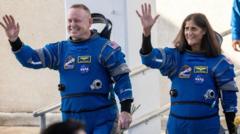When astronauts Suni Williams and Butch Wilmore embarked on their much-anticipated mission aboard the Boeing Starliner spacecraft, they were prepared for an eight-day test flight. However, technical difficulties arose, leaving them in a precarious situation as they approached the International Space Station (ISS) last year, with malfunctioning thrusters preventing them from docking. "We were uncertain if we'd make it back home," Wilmore shared with BBC News, two months after their eventual successful re-entry to Earth.
Their harrowing experience began in June 2024, with plans swiftly derailed as the astronauts faced the daunting knowledge that they may not return home. Initially, it appeared that their spacecraft would not be fit for a safe return, forcing mission control to consider alternative measures which included a rescue flight from SpaceX. Fortunately, with critical assistance, they managed to dock at the ISS shortly after launching into space, sparking hope for a return journey.
Despite being classified as "stranded," the astronauts confirmed that they were never completely without options; the ISS is always equipped with other retrievable vehicles in case of emergencies. While their nine-month stay was atypical, both astronauts embraced the unique opportunity to conduct countless experiments and build resilience during their extended mission.
Amidst their experiences, they encountered unexpected political discourse, with former U.S. President Donald Trump attributing their prolonged mission to President Joe Biden. Wilmore and Williams chose to overlook such commentary focusing instead on their training and the support from their teams. "We understood that space flight is a complex venture," Wilmore explained, reflecting on their mindset throughout the journey.
Recently back on Planet Earth, they reported feeling remarkably fit due to rigorous exercise regimens they maintained throughout their mission. Wilmore noted that his daily squats and deadlifts led to an increased physical strength upon re-entering gravity. Williams echoed these sentiments but acknowledged the difficulty of readjusting to weight after spending numerous months in microgravity.
Both astronauts have since engaged with NASA and Boeing, working diligently to rectify the setbacks faced by the Starliner spacecraft. "We remain hopeful for future flights aboard the Boeing Starliner," Wilmore expressed, highlighting the spacecraft's promising potential. With technical challenges ahead, both agreed they would jump at the chance to board the Starliner again as it continues to evolve for future space explorations. Williams stated, "It offers unique capabilities that can greatly benefit the next generations of astronauts."



















